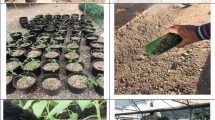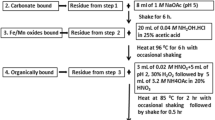Abstract
Little information is available concerning the efficacy of chelates applied to biosolids (sewage-sludge)-treated soil for heavy-metal removal. The purpose of the experiment was to determine the availability to sunflower (Helianthus annuus L.) and hybrid poplar (Populus deltoides Marsh. × P. nigra L.) seedlings, of non-essential (Cd, Ni, Pb) and essential heavy metals (Cu, Fe, Mn, Zn) in field soil injected with biosolids since 1976 and treated with ethylenediamine-tetraacetic acid (EDTA) in 2001. Sunflower was grown at two densities, 20 000 and 60 000 plants/ha, and poplar at 10 000 plants/ha. The tetrasodium salt of EDTA was applied at rates of 0, 0.5, 1, and 2 g EDTA salt per kg surface (25-cm depth) soil. The EDTA did not affect uptake by poplar of the three non-essential (Cd, Ni, Pb) and four essential (Cu, Fe, Mn, Zn) heavy metals. For sunflower, the 1.0 g/kg rate of chelate addition resulted in maximal removal of the three non-essential heavy metals (Cd, Ni, Pb). Uptake of the essential heavy metals by sunflower was little affected by the EDTA. At the 20 000 plants/ha density, leaves of sunflower grown with 1.0 g EDTA Na4ċ2H2O per kg soil accumulated more Cd, Ni, and Pb than leaves of sunflower grown without the EDTA salt. At this density, concentrations of Cd in leaves of sunflower without EDTA and with 1.0 g/kg EDTA salt were 2.2 and 6.5 μg/g, respectively; for Ni, they were 6.7 and 19.2 μg/g, respectively; and for Pb, they were 15.6 and 46.9 μg/g, respectively. At the 60 000 plants/ha density, stems of sunflower grown with 1.0 g EDTA Na4ċ2H2O per kg soil accumulated more Cd, Ni, and Pb than stems of sunflower grown without the EDTA salt. At this density, concentrations of Cd in stems of sunflower without EDTA and with 1.0 g/kg EDTA salt were 0.6 and 4.6 μg/g, respectively; for Ni, they were 1.7 and 17.6 μg/g, respectively; and for Pb, they were 5.2 and 42.8 μg/g, respectively. Removal of the non-essential heavy metals by sunflower was greater at the higher plant density (60 000 plants/ha) compared to the lower one (20 000 plants/ha).
Similar content being viewed by others
References
Anderson C W N, Brooks R R, Stewart R B and Simcock R 1998 Harvesting a crop of gold in plants. Nature 395, 553–554.
Bastian R K 1997 Biosolids management in the United States.Water Environ. Technol. 9(5), 45–50.
Beeson K C 1941 The mineral composition of crops with particular reference to the soils in which they were grown. USDA Misc. Publ. 369. U.S. Dep. Agric., Washington, DC. 164 pp.
Blaylock M J, Salt D E, Dushenkov S, Zakharova O, Gussman C, Kapulnik Y, Ensley B D and Raskin I 1997 Enhanced accumulation of Pb in Indian mustard by soil-applied chelating agents. Environ. Sci. Technol. 31, 860–865.
Brooks R R 1998 General introduction. In Plants That Hyperaccumulate Heavy Metals. Ed. R R Brooks. pp. 1–14. CAB International, Wallingford, Oxon, UK.
Chapman H D Ed. 1973 Diagnostic Criteria for Plants and Soils. 2nd printing. Quality Printing Co., Abilene, TX. 793 pp.
Deram A, Petit D, Robinson B H, Brooks R R, Gregg P E H and van Halluwyn C 2000 Natural and induced heavy-metal accumulation by Arrhenatherum elatius: Implications for phytoremediation. Commun. Soil Sci. Plant Anal. 31, 413–421.
Geebelen W, Vangronsveld J, Adriano D C, Van Poucke L C and Clijsters H 2002 Effects of Pb-EDTA and EDTA on oxidative stress reactions and mineral uptake in Phaseolus vulgaris. Physiol. Plant. 115, 377–384.
Huang J W, Chen J, Berti W R and Cunningham S D 1997 Phytoremediation of lead-contaminated soils: Role of synthetic chelates in lead phytoextraction. Environ. Sci. Technol. 31, 800–805.
Kirkham M B 1975 Trace elements in corn grown on long-term sludge disposal site. Environ. Sci. Technol. 9, 765–768.
Kirkham M B 1983 Elemental content of soil, sorghum and wheat on sludge-injected agricultural land. Agric. Ecosyst. Environ. 9, 281–292.
Kirkham M B 2000 EDTA-facilitated phytoremediation of soil with heavy metals from sewage sludge. Int. J. Phytoremediation 2, 159–172.
Kirkham M B, Johnson D E Jr, Kanemasu E T and Stone L R 1983 Canopy temperature and growth of differentially irrigated alfalfa. Agric. Meteorol. 29, 23–246.
Lasat M M 2002 Phytoextraction of toxic metals: A review of biological mechanisms. J. Environ. Qual. 31, 109–120.
Li Y-M, Chaney R, Brewer E, Roseberg R, Angle J S, Baker A, Reeves R and Nelkin J 2001 Development of new technology for phytoextraction of Ni – Commercial considerations. Conf. Chair: L Evans. ICOBTE Conference Proceedings, 29 July–2 August 2001. 6th Int. Conf. on Biogeochemistry of Trace Elements, Univ. of Guelph, Guelph, Ontario, Canada. 213 pp.
Lindsay W L and Norvell W A 1978 Development of a DTPA soil test for zinc, iron, manganese, and copper. Soil Sci. Soc. Am. J. 42, 421–428.
Liphadzi S M 2002 Chelate-assisted phytoremediation of soil with heavy metals in biosolids. Ph.D. Thesis, Kansas State University, Manhattan, Kansas. 243 pp.
Madrid F, Liphadzi M S and Kirkham M B 2003 Heavy metal displacement in chelate-irrigated soil during phytoremediation. J. Hydrol. 272, 107–119.
Malik M, Chaney R L, Brewer E P, Li Y-M and Angle J S 2000 Phytoextraction of soil cobalt using hyperaccumulator plants. Int. J. Phytoremediation 2, 319–329.
National Oceanic and Atmospheric Administration 2001 Climatological Data. Kansas. Vol. 115, Nos. 7, 8, 9, and 10. Nat. Environ. Satellite, Data, and Information Service, Nat. Climatic Data Center, Asheville, NC.
Reed C H 1973 Equipment for incorporating sewage sludge and animal manures into the soil. Compost Sci. 14(6), 30–32.
Robinson B, Mills T and Clothier B 1999 Phytoremediation of heavy-metal contaminated soils. WISPAS, A Newsletter about Water in the Soil-Plant Atmosphere System 72, 1–2. (Published by Environment Group, HortResearch, Palmerston North, New Zealand.)
Robinson B H, Mills T M, Petit D, Fung L E, Green S R and Clothier B E 2000 Natural and induced cadmium-accumulation in poplar and willow: Implications for phytoremediation. Plant Soil 227, 301–306.
Salt D E, Smith R E and Raskin I 1998 Phytoremediation. Annu. Rev. Plant Physiol. Plant Mol. Biol. 49, 643–668. SAS Institute 1998 SAS/STAT, release 6. 12 edition. Statistical Analysis Systems (SAS) Institute, Cary, NC.
Smith J L, McWhorter D B and Houck C P 1977 Land application of sludges using continuous subsurface injection. In Sludge management disposal and utilization. Information Transfer, Inc., Rockville, MD. pp. 113–118.
Sposito G, Lund L J and Chang A C 1982 Trace metal chemistry in arid-zone field soils amended with sewage sludge. I. Fractionation of Ni, Cu, Zn, Cd, and Pb in solid phase. Soil Sci. Soc. Am. J. 46, 260–264.
Thayalakumaran T, Vogeler I, Scotter D R, Robinson B H, Clothier B E and Green S R 2000 Chelation therapy for dirty soils. In 2000 Agronomy Abstracts. Am. Soc. Agronomy, Crop Sci. Soc Am., Soil Sci. Soc. Am., Madison, WI. 202 pp.
United States Environmental Protection Agency 1992 Technical support document for land application of sewage sludge. Volume I (Revised). Office of Water, U.S. Environmental Protection Agency, Washington, D.C. 821 pp. (Available from the National Technical Information Service, Springfield, VA 22161. Order document no. PB93–110575.)
Vogeler I, Green S R, Clothier B E, Kirkham M B and Robinson B H 2001 Contaminant transport in the root zone. In Trace Elements in Soil. Bioavailability, Flux, and Transfer. Lewis Publishers, Boca Raton, FL. pp. 175–197.
Whitney D A 1998 Micronutrients: zinc, iron, manganese and copper. In Recommended Chemical Soil Test Procedures for the North Central Region. Ed. J R Brown. pp. 41–44. Bull. SB 1001. Missouri Agric. Exp. Stn., Columbia.
Author information
Authors and Affiliations
Corresponding author
Rights and permissions
About this article
Cite this article
Liphadzi, M., Kirkham, M., Mankin, K. et al. EDTA-assisted heavy-metal uptake by poplar and sunflower grown at a long-term sewage-sludge farm. Plant and Soil 257, 171–182 (2003). https://doi.org/10.1023/A:1026294830323
Issue Date:
DOI: https://doi.org/10.1023/A:1026294830323




